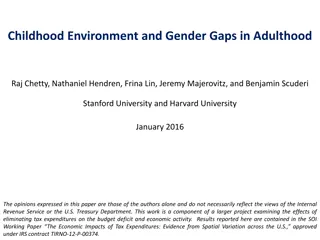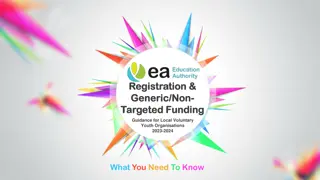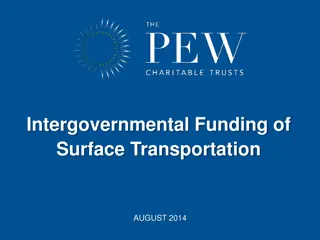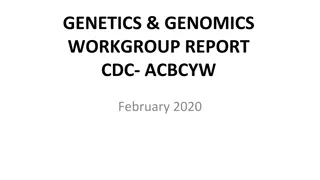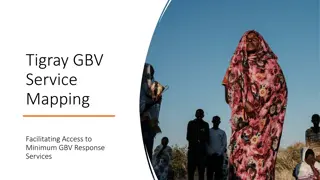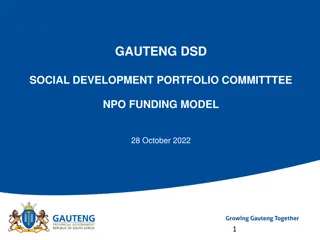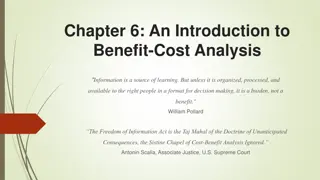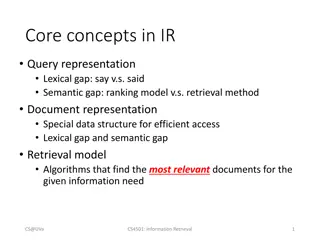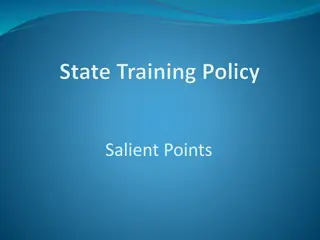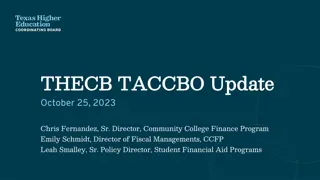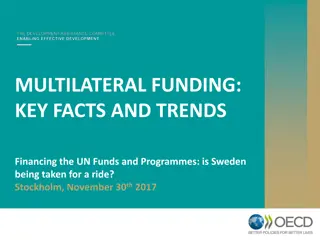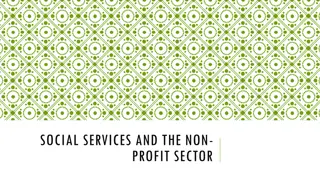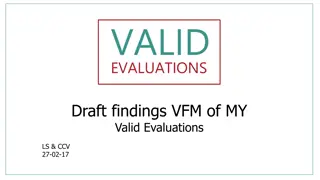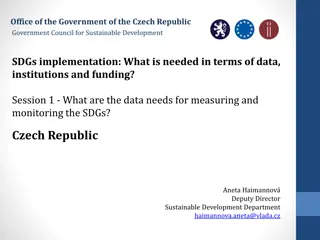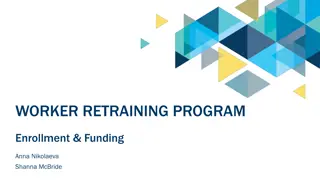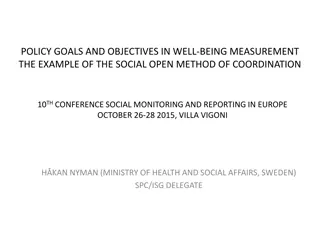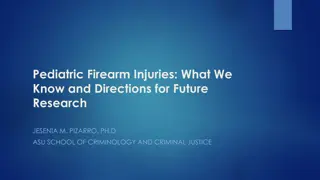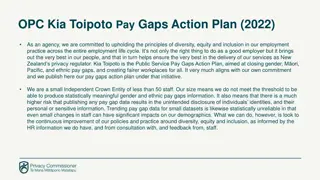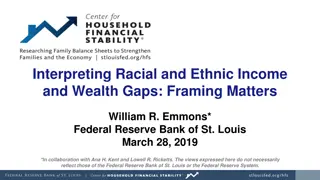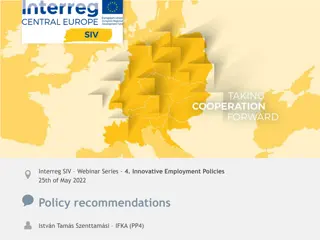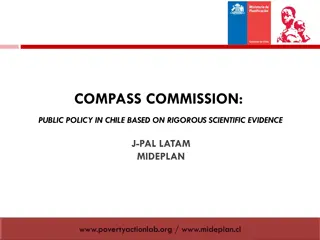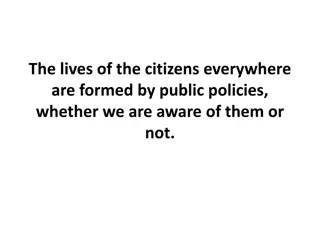Social Policy Analysis: Challenges and Gaps in Children's Services Funding
The presentation delves into the examination of what is working, what isn't, along with gaps in evidence related to children's services funding. It provides insights into the impact of austerity measures, cuts in benefit spending, and the challenges faced in safeguarding and preventative interventions. Moreover, it highlights the erosion of the welfare state's protective capacity and the need for a more comprehensive approach to address structural inequalities in social policies.
Download Presentation

Please find below an Image/Link to download the presentation.
The content on the website is provided AS IS for your information and personal use only. It may not be sold, licensed, or shared on other websites without obtaining consent from the author. Download presentation by click this link. If you encounter any issues during the download, it is possible that the publisher has removed the file from their server.
E N D
Presentation Transcript
Presentation to Independent Care Review team 24 March 2021
What is working, what is not, what is the evidence on those things and what are the gaps in evidence
INTRO Leon Feinstein. A little bit of wider context
References References Children s Commissioner s Office (2018) / Institute of Fiscal Studies Public Spending on Children in England: 2000 to 2020. Elaine Kelly, Tom Lee, Luke Sibieta and Tom Waters DFE (2021) Children s social care cost pressures and variations in unit costs. Lisa Holmes, Rees Centre, University of Oxford. Children s Commissioner s Office (2019) Estimating Children s Services spending on vulnerable children. Vulnerability technical spend report. Stanford & Lennon The Conservative Governments Record on Social Policy from May 2015 to pre- COVID 2020: Policies, Spending and Outcomes . An assessment of social policies and social inequalities on the eve of the COVID-19 pandemic. February 2021. Edited by Polly Vizard and John Hills ADCS Submission: 2020 COMPREHENSIVE SPENDING REVIEW The Association of Directors of Children s Services Ltd September 2020
Context 1. Austerity Context 1. Austerity Total benefit spending per child was about 5,000 in 2017 18. There has been a real-terms cut of 17% between 2009 10 and 2019 20. Families with children have faced large cuts in benefit spending since 2010. Education spending has been mostly protected from real-terms cuts since 2010, except for further education and school sixth forms, where spending per student is the same in real terms in 2020 as it was in 1990. Pressure on the high-needs budget is growing. Within this total change, there has been a significant reorientation of spending towards spending on Safeguarding and Looked After Children, which has been largely frozen in real terms since 2009 10. In contrast, spending on early and preventative interventions, such as Sure Start and young people s services, has been cut by around 60% in real terms between 2009 10 and 2016 17. Data, particularly on health spending, could be significantly improved.
Vizard and Hills (2021) Vizard and Hills (2021) The protective capacity of the welfare state had been eroded in multiple ways, especially in relation to working age adults and children. Resource, workforce and capacity pressures had built up across multiple public services simultaneously, resulting in a failure to meet current needs, compromising quality, and eroding the resilience of public services to shocks. The welfare state and public services were adapting to the rising and different needs and circumstances of the 21st century, but not fully. While there was more emphasis on skills in the context of the post- Brexit agenda, social investment in human capital at different life- stages and across different critical life domains continued to be given insufficient priority. Looking across the 10 social policy areas, on the eve of the COVID- 19 pandemic, there was mounting evidence of a slowdown in social progress and of deep structural inequalities across multidimensional areas of life that were widening against some key indicators.
Context 2: Pandemic Context 2: Pandemic The impact on children and their families must not be underestimated, children s services across the country are preparing themselves for a level of unprecedented demand. We do not yet know if this surge in demand will translate into persistent, heightened demand. The worsening economic situation and job losses will almost certainly impact on the resilience of families, particularly those living in areas of high deprivation and those families who receive benefits. Either way Covid-19 will have a long-lasting legacy on children s lives and in children s services.
Context 3. Spending pressures. Context 3. Spending pressures. 20 years of seeking EI savings 20 years of seeking EI savings Holmes: The findings from this small-scale study, in particular the responses from the cost pressures survey corroborate recent reviews and studies highlighting the increased demand and budgetary pressures facing local authority children s services departments at the moment. This study also highlights the need for mechanisms to link cost data to information about activity, needs and circumstances of children and young people, service receipt and outcomes achieved.
1. Kinship care, special guardianship and adoption Julie Selwyn
Whats working well: What s working well: Permanence Permanence to ensure that children have a secure, stable, and loving family to support them throughout childhood and beyond and to give them a sense of security, continuity, commitment, identity, and belonging. (The Care Planning Regulations, 2015, p 22). More children leaving care on permanence orders
Population Census 2011 Population Census 2011 152,910 children living with relatives without a parent in the h/hold 7% growth in the kinship population since previous census 32% of the children were from an ethnic minority One in every 46 children living in the poorest 20% of areas in England was a child living in kinship care. About half (51%) the children were living with a grandparent 23% with a sibling
The Poor Relations study The Poor Relations study (Big Lottery funded) (Big Lottery funded) My mum is dead and my dad hates me. (Age 15yrs) My mum didn t want me. (Age 15yrs) [parents] were drug addicts and I went over one day to their house when he was 6 weeks old. He was lying trying to feed hisself with a bottle and all these cushions. I just (pushed) through this crowd in the bedroom, they were doing all different things with drugs. So, I just the took the child out. G/mum She s winning medals, winning leagues . But last Thursday it cost me 14 for an hour s training session and then I had no money for the weekend. Then ( child s sibling) comes. Have you got 30p Nana and I hate having to say I haven t got it. G/mum In-depth interviews 80 kinship carers and 80 children Poverty prevalent just over a third (34%) had incomes of less than 200 per week Poverty result of taking on the care of the child/ren
Characteristics of children Characteristics of children and carers and carers Children Kinship Carers Maltreatment Stability - 6% disruption rate of SGOs Felt loved and cared for Educational outcomes better than those in care but not as good as the general population Supported extended transition to adulthood Mainly single female carers Small support networks out of step with their age group Poverty, stress and disability Challenges in managing contact
Childrens and carers Children s and carers worries worries Children Carers If my Nan dies, what will happen to me? [Siblings] living with mum who lives with an aggressive boyfriend. It s hard I see my mum picking [my brother and half-sister] up [from school] and I think Why couldn t that be me? [My mum] gets drunk and I don t like that I hate her...because we always get into fights. (8yrs) I don t know what goes on in her head, when your mother sits there and tells you that she doesn t want you. I feel like I m trapped, I feel like I m in a cage. It s felt like prison for a long time. (Sibling carer and a child herself) [Mother] wants me to look after her and she s ill a lot -not because of the HIV, it s usually because of the drugs
What could be improved for What could be improved for kinship carers and children kinship carers and children A regular allowance and financial support especially at the start of the placement SWs who are trained and can help with child benefit/ guardian/DLA application Development of bereavement services Public information campaign. Adoption should not be used as a threat Support for contact
Adoption: Adoption: Consensus statement from 12 Consensus statement from 12 international researchers that adoption is international researchers that adoption is protective and aids developmental recovery protective and aids developmental recovery Majority securely attached. Children have a greater sense of belonging compared with those in foster care. Stability - 3.2% disruption rate 37,000 adoptions tracked over 12yrs Supported into adulthood. Young people have a sense of a future
Adoption Adoption - - some key findings findings some key Children have multiple and overlapping difficulties: FASD, autism, developmental delay, attachment difficulties, sexualised behaviour, ADHD, anxiety etc. Disruption factors - age at entry and at placement, multiple moves, delays, APV. Being a teenager. A third of families struggling and support services have been focused on the start and not the teenage years. RAAs are fledgling organisations to be supported. Very successful leadership programme and a new group of 30 sector leaders.
What could be improved for What could be improved for adoptive parents and children adoptive parents and children The Adoption Support Fund - change the name! Contact plans need to move into the 21stcentury while ensuring they are in children s best interests. Life story work/books are poor or non existent for many children An adoption support offer would increase the number and capacity of adoptive families. Remove the uncertainty of yearly funding announcements.
Some overarching issues Some overarching issues Many children need help with difficulties e.g. PTSD, trauma, anxiety/depression, ADHD. Services are very variable and in some areas non existent/ inadequate. We ve known this for a long time. Interventions are provided but evaluated differently and findings can t be compared. No core set of measures. Are evidence based interventions being offered to children and families? Multiple high profile sector reviews but not seeing children and young people s needs in the round with sectors interlinked. Too siloed an approach
References References Selwyn J. et al. (2019) Adoption in the service of child protection. An international interdisciplinary perspective. Psychology, Public Policy and Law. https://doi.org/10.1037/law0000192 Selwyn J. (2017) The adoption of looked after maltreated children in England: challenges, opportunities and outcomes. Developing Practice: The Child, Youth and Family Work Journal (Australia), 47, 50-63 Selwyn, J. Meakings, S. & Wijedasa, D. (2015). Beyond the adoption order: challenges, interventions and disruptions. London BAAF Selwyn, J & Masson, J.M. (2014). Adoption, special guardianship and residence orders: a comparison of disruption rates. Family Law Journal, 44,1709-1714 Selwyn J and Nandy, S. (2014) Using census data to estimate the extent of formal and informal care by relatives. Child and Family Social Work, 19,1, 44-54 Selwyn J., and Nandy, S. (2012) Sibling kinship carers in England: evidence from the UK Population Census 2001. Children and Youth Services Review. 34, 194-199 Selwyn J, Farmer E, Meakings S and Vaisey P (2013) library/sites/sps/migrated/documents/report.pdf The Poor Relations? http://www.bristol.ac.uk/media-
2. Commissioning, and stability Lisa Holmes
Commissioning Commissioning placements placements Small proportion of placement skew the budget: Lack of evidence informed decision making. Often costs rather than needs led. Market pressures and higher costs associated with higher staffing ratios Up to 16% of the budget spent on the 10 highest cost placements Weekly unit costs in excess of 7,000 Lack of control over annual uplifts, especially where supply is limited
Commissioning Commissioning placements: Some placements: Some emerging solutions emerging solutions The establishment of regional and/or sub-regional consortia: Establish a clear strategic vision for the use of residential care: Address market pressures Right placement at the right time Transparency in commissioning and procurement practices Agreed definition of Therapeutic Residential Care Efficiencies in quality assurance and placement monitoring Examine use and capacity of residential care
Residential care: Issues Residential care: Issues and what is not working and what is not working Placement of last resort Geographical location: children s homes are not evenly distributed. A quarter of all placements are in the North West. Some children are placed at a distance Unregulated placements: growing use >12,800 children and young people in 2018-19 Variable quality: 4 out of 5 homes rated as good or outstanding by Ofsted (Last detailed analysis in 2014 more than a quarter had at least 5 previous placements)
Therapeutic residential care: Therapeutic residential care: Consensus statement from 32 international Consensus statement from 32 international researchers across 11 countries researchers across 11 countries Set of guiding principles: Residential care has a role and purpose in child welfare systems. If used in a planned and purposeful way to meet the needs of children. Safety first Internationally agreed definition of therapeutic residential care. Family engagement Contextually grounded Relational
An alternative to An alternative to commissioning: Developing commissioning: Developing local authority provision local authority provision Aim to reduce externally provided placements and children being placed out of area 8 non-negotiables No Wrong Door developed by North Yorkshire Children s Services Residential hub with an integrated system of services, support and accommodation 10 distinguishing features 4 provocations
Stability Stability Predominantly measured by placement stability and number of placements Relational stability A care system that breaks rather than makes relationships an unintended consequence (Care inquiry, 2013) OCC research extended focus to social worker and school stability
Lifelong Links: Some key Lifelong Links: Some key messages from the evaluation messages from the evaluation Objectives set by children and young people at the outset Positive impact on the lives of children in care: Contribution to young people s identity Identified between 1 and 25 people who they wanted to connect with Build own narratives and build safe connections Restorative (birth families, previous care carers, teachers and social workers) 91% positive outcome from direct contact More children and young people remained in their placements than comparison group (74%: 41%) Prevents disconnects in the lives of children in care
References References Bellonci, C. and Holmes, L. (2020) Debate: The greater the needs the lesser the evidence therapeutic residential care for young people, Child and Adolescent Mental Health, doi:10.1111/camh.12448. Holmes, L., Neagu, M., Sanders-Ellis, D. and Harrison, N. (2020) Lifelong Links evaluation report, London: Department for Education. Bellonci, C., Holmes, L. and Whittaker, J. (2019) Re-thinking Therapeutic Residential Care (TRC) as a preventative service: Examining developments in the US and England, Residential Treatment for Children and Youth, 36:1, 35-53. Holmes, L., Connolly, C., Mortimer, E. and Hevesi, R. (2018) Residential Group Care as a last resort: Challenging the rhetoric, Residential Treatment for Children and Youth, 35:3, 209-224. Lushey, C., Hyde-Dryden, G., Holmes, L. and Blackmore, J. (2017) No Wrong Door evaluation report, London: Department for Education. Whittaker, J., Holmes, L., Del Valle, J. et al (2016) Therapeutic Residential Care for Children and Youth: A Consensus Statement of the International Work Group on Therapeutic Residential Care, Residential Treatment for Children & Youth, 33:2, 89-106. Whittaker, J., Del Valle, J. and Holmes, L. (eds) (2014) Therapeutic Residential Care with children and youth: Developing evidence- based international practice, London: Jessica Kingsley Publishers.
3. Education, care and after Neil Harrison
School outcomes School outcomes Two studies for Nuffield Foundation reported in 2015 and 2020 Key Stage 4 outcomes for children (a) in care, and (b) in need Protective factors: Entering care at a younger age Placement stability and more than 12 months in care Most recent placement being in foster care (rather than residential or kinship) Lower SDQ scores fewer self-reported difficulties Having a supportive teacher or other school staff member Poor data on disability: unclear impact on school and later life outcomes and issues with continuity of support
Trauma Trauma- -informed practice informed practice in schools in schools Timpson Programme exploring impact of attachment and trauma awareness training in 300 English schools across 25 local authorities Reporting June 2022 interim working paper: 64% of staff report making changes resulting from training Increased emphasis on empathy, emotions, trust and wellbeing Positivity highest among senior staff training as a catalyst for whole school changes in policy and macro-practices ~80% of staff report improvements for vulnerable children resulting from the training
Effectiveness of virtual Effectiveness of virtual schools schools Wide divergence in GCSE outcomes for children in care between different local authorities Attainment 8 scores vary from 13.3 to 29.6 (2017-2019 average) No readily-apparent relationship with local context (e.g. deprivation) Key role for virtual schools Advocacy, commissioning and service delivery Little systematic research or evaluation since pilot phase What is effective practice across 151 organisations? Resourcing, organisational structure, leadership, decision-making New study for KPMG Foundation reporting April 2022
Labour market Labour market transitions transitions Care leavers significantly more likely not be in education, employment or training (NEET) at 21 than other young people Study for Nuffield Foundation reporting Summer 2021 Tracking 1995/96 birth cohort general population and four care groups Linked data from care, education, employment and benefit records Very early findings: Importance of Key Stage 4 outcomes, especially English and maths Lack of ambition in post-16 options for mid-attainers Group in care after 14, but not statutory care leavers particularly vulnerable Large differences between local authorities also in subjective wellbeing
Access to higher Access to higher education education Study for Unite Foundation (reported February 2020) and others Many more care leavers in HE than previously thought ~20% by 21 Headlines: Low participation nearly solely due to GCSE outcomes and disability Significant issue with early withdrawal from higher education particular challenges for disabled care leavers and those with children Those that graduate have very positive outcomes, on average Postcode lotteries by local authorities and/or universities Issues of definition and adjacent groups (e.g. formerly in kinship care) Important issues remain, but area of relative success internationally
References References Berridge, D., N. Luke, J. Sebba, S. Strand, M. Cartwright, E. Staples, L. McGrath-Lone, J. Ward, J. and A. O Higgins (2020) Children in need and children in care: Educational attainment and progress. Bristol/Oxford: University of Bristol, andUniversity of Oxford. Harrison, N. (2017) Moving on up: care leavers and care-experienced students pathways into and through higher education. Winchester: National Network for the Education of Care Leavers. Harrison, N. (2020) Attachment and trauma awareness training: analysis of pre-Covid survey data from staff in 24 primary schools. Oxford: University of Oxford Harrison, N. (2020) Patterns of participation in higher education for care-experienced students in England: why has there not been more progress? Studies in Higher Education 45(9): 1986-2000. Harrison, N., Z. Baker and J. Stevenson (in press) Employment and further study outcomes for care-experienced graduates in the UK. Awaiting publication in Higher Education. O Neill, L., N. Harrison, N. Fowler and G. Connelly (2019) Being a student with care experience is very daunting : findings from a survey of care experienced students in Scottish colleges and universities. Glasgow: CELCIS. Sebba, J., and D. Berridge (2019). The role of the Virtual School in supporting improved educational outcomes for children in care. Oxford Review of Education, 45(4), 538-555. Sebba, J., D. Berridge, N. Luke, J. Fletcher, K. Bell, S. Strand, S. Thomas, I. Sinclair and A. O Higgins (2015) The educational progress of looked after children in England: Linking care and educational data. Oxford/Bristol: University of Oxford and University of Bristol. Stevenson, J., Z. Baker, N. Harrison, B. Bland, S. Jones-Devitt, A. Donnelly, N. Pickering and L. Austen (2020) Positive impact? What factors affect access, retention and graduate outcomes for university students with a background of care or family estrangement? Bristol: Unite Foundation.
International evidence and concluding remarks Harriet Ward
International concerns: high International concerns: high numbers of infants removed numbers of infants removed from birth parents from birth parents Increase in removals of newborns (under one month) High proportion of entrants to care are under one year old: 19% in England; 25% in USA Concerns in at least 18 countries led to: International Network on Infants and Toddlers in Child Protection In England 10% increase in newborns in care proceedings (2007-2016)
International concerns: International concerns: reasons for infant removals reasons for infant removals Poverty and poor housing (universal factor in infant removal) Abuse or neglect are primary causes in Australia (data not comparable); England (63%); Portugal (71%) ; Spain (62%) Increase in England possibly caused by: Greater understanding of consequences of abuse and neglect Changes in thresholds BUT also Greater prevalence of parental stressors (poverty, precarious employment), and problems (eg substance misuse, mental health problems, domestic abuse) Reduction of/absence of parental support services
International evidence: International evidence: benefits of care benefits of care Research on care in France, Norway, Australia, the UK, and some (though not all) studies in USA shows care generally has a positive impact on children s welfare. Maltreated children tend to do better in care than those who remain with or return to abusive or neglectful birth parents
International evidence: International evidence: poor outcomes poor outcomes Gravity and duration of abuse before entry to care (France, Australia, England) Instability of care (France, Sweden, Netherlands, Australia, USA, UK) Stigma, small meannesses and lack of psychotherapeutic support (Scandinavia, France, UK, Australia) Inadequate support for care leavers (at least 18 countries)
Outcomes of open adoption Outcomes of open adoption from care in New South Wales from care in New South Wales Adoptees (60) Care leavers (41) Extensive experience of abuse and neglect More mental health issues Better education/employment/ adult functioning A committed and supportive adoptive parent Fewer adverse experiences Fewer mental health issues Fewer qualifications/More NEET
Conclusion: key themes Conclusion: key themes Care system needs to be part of an integrated spectrum of services designed to meet children s needs whoever they are living with, wherever they are placed: Consider the whole child, from birth to adulthood Important not to think in silos Relational stability/psychological permanence is imperative Money matters


